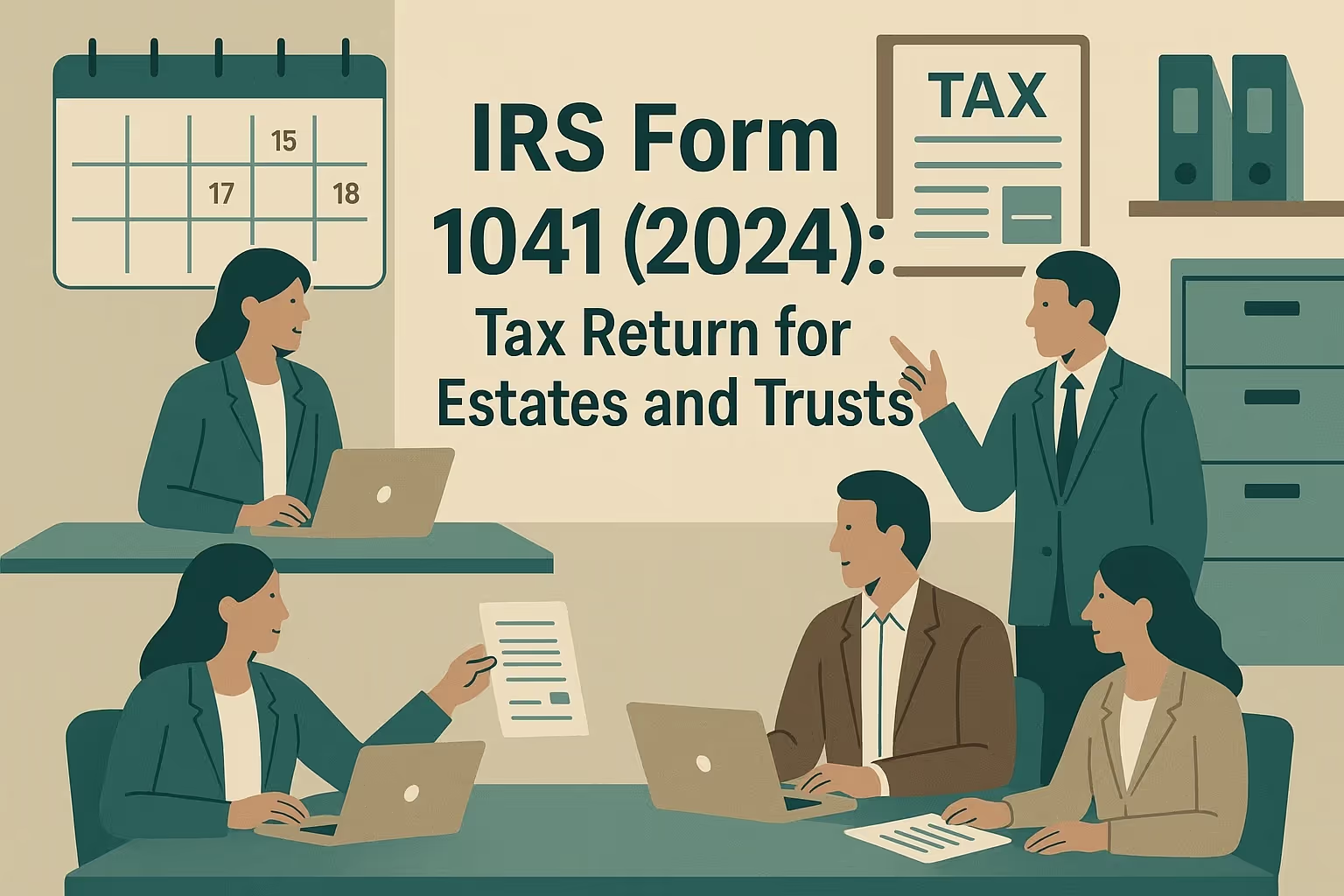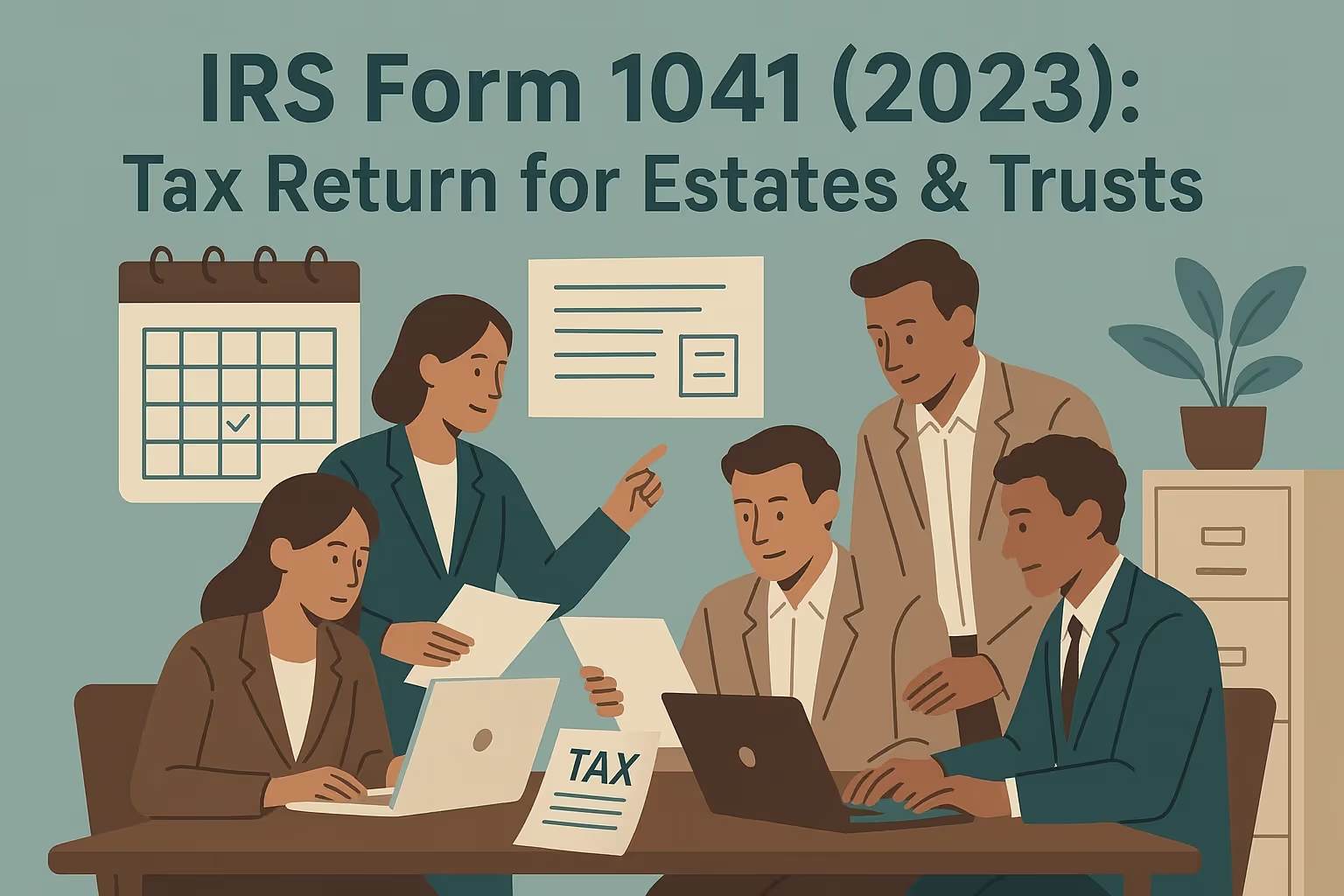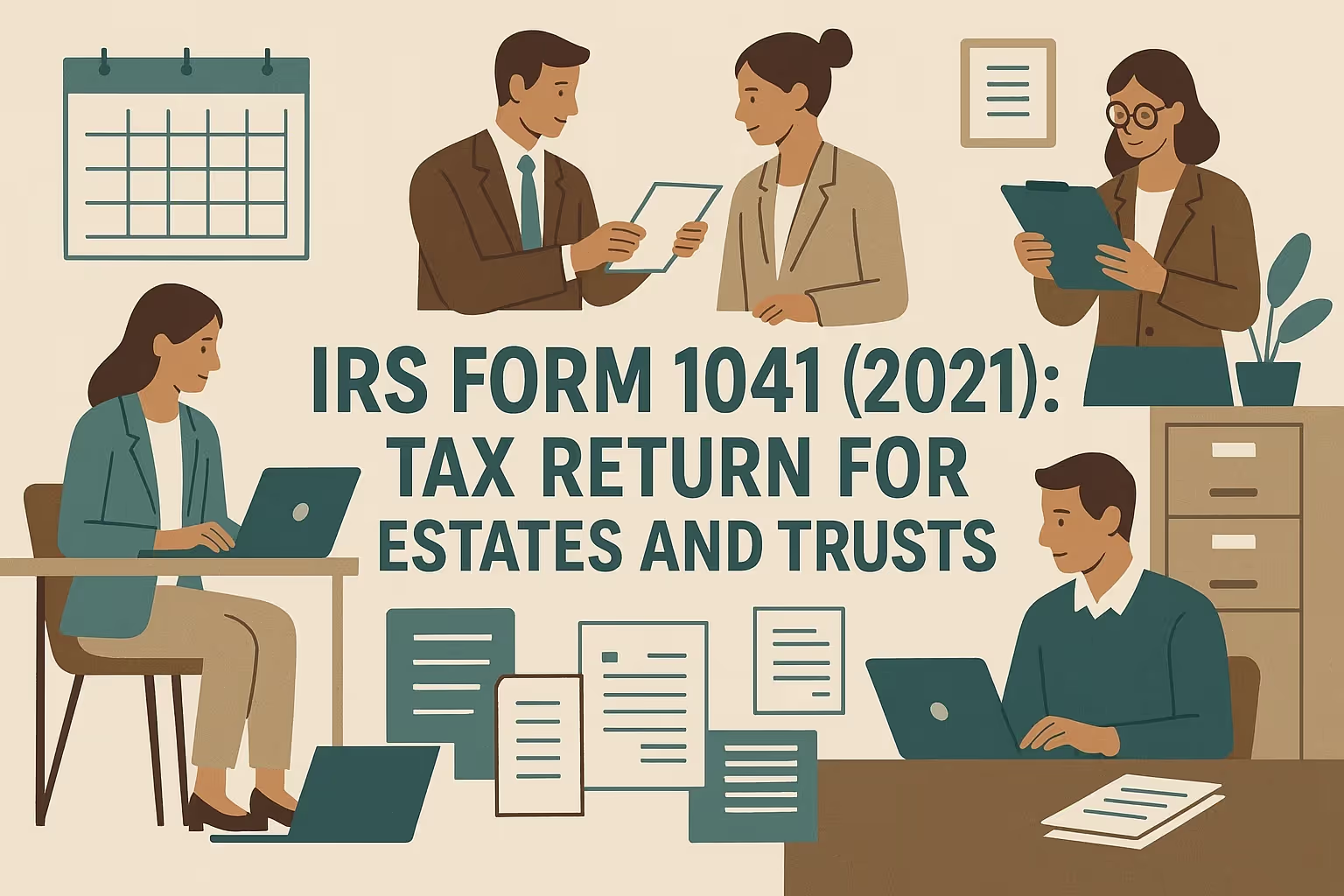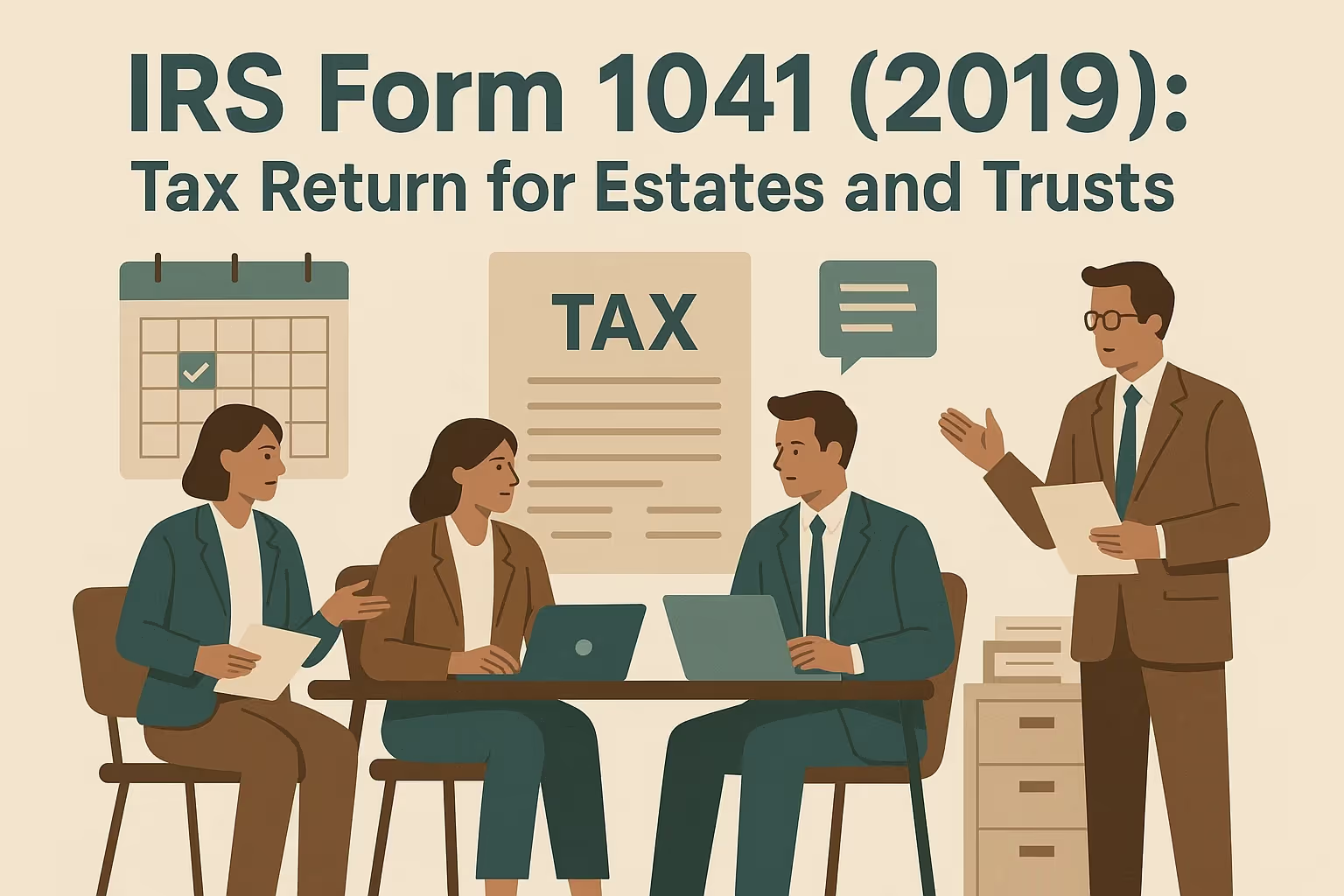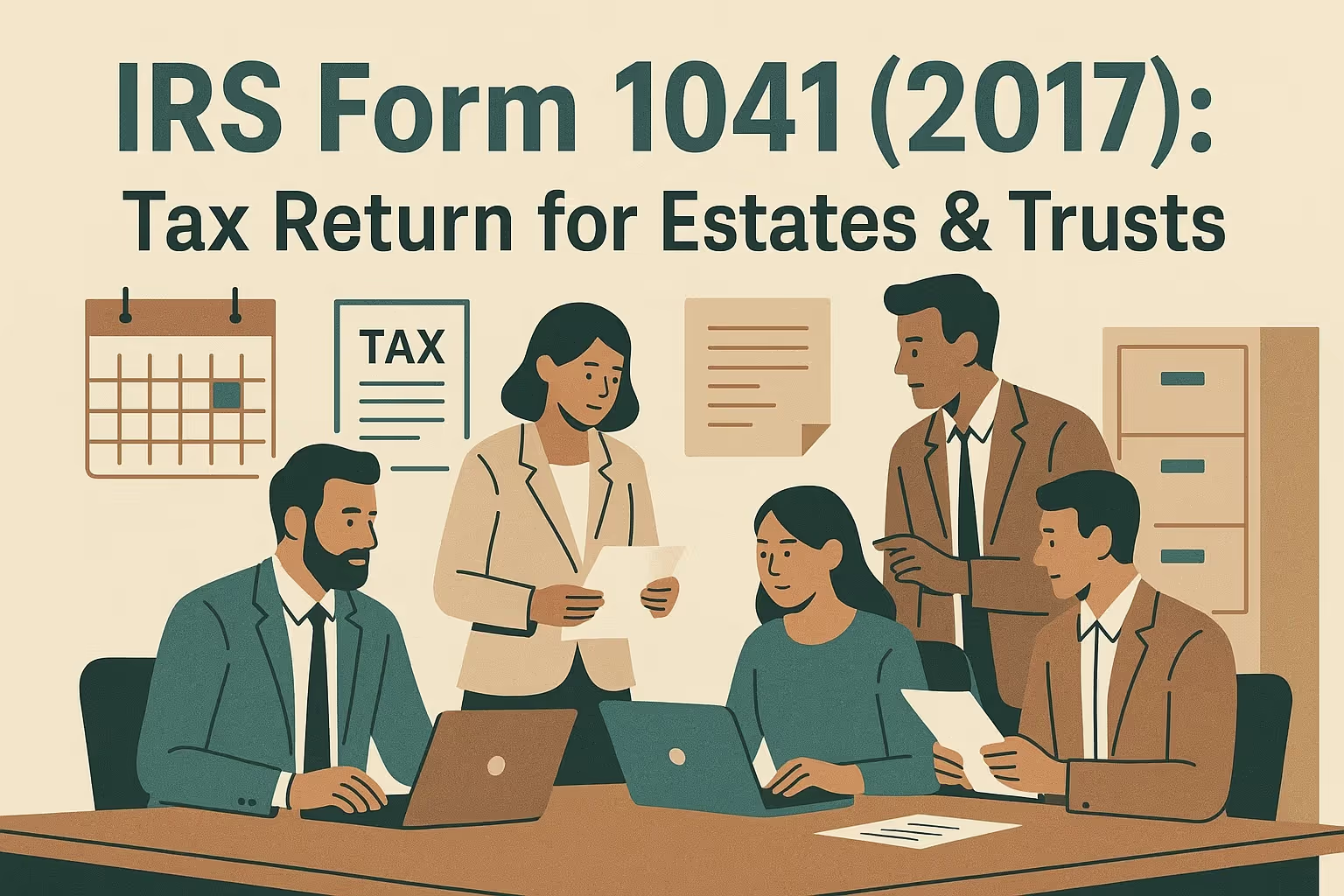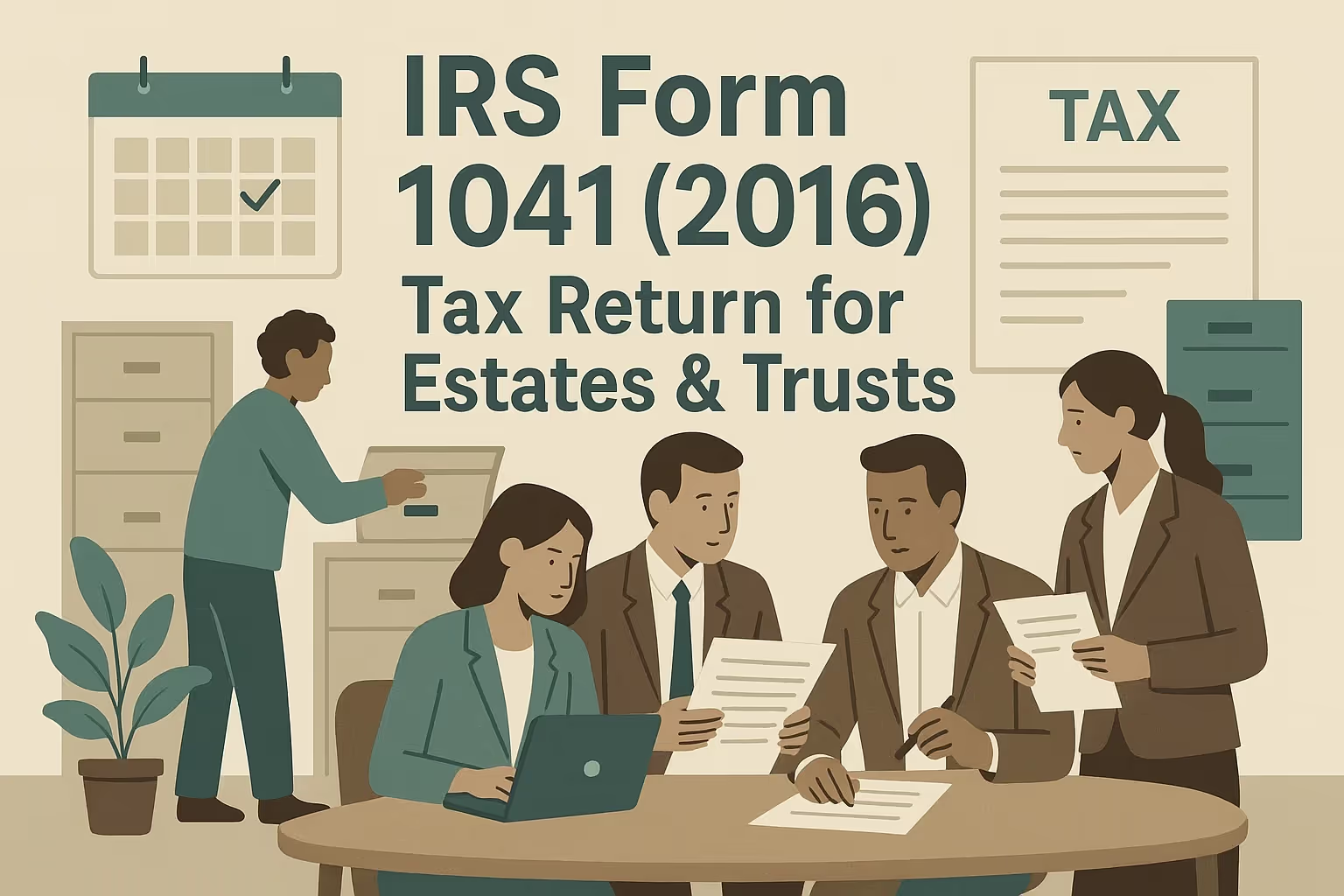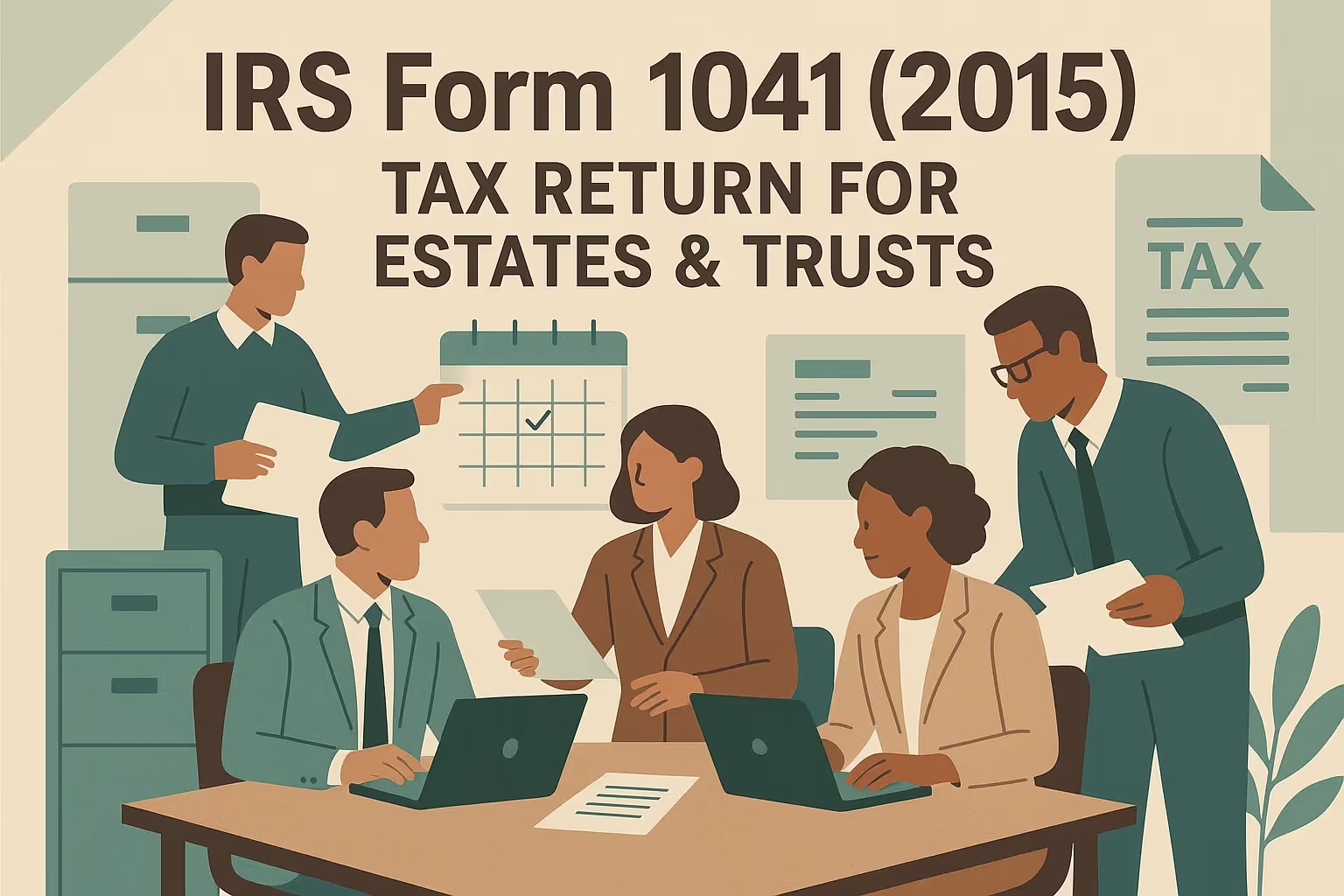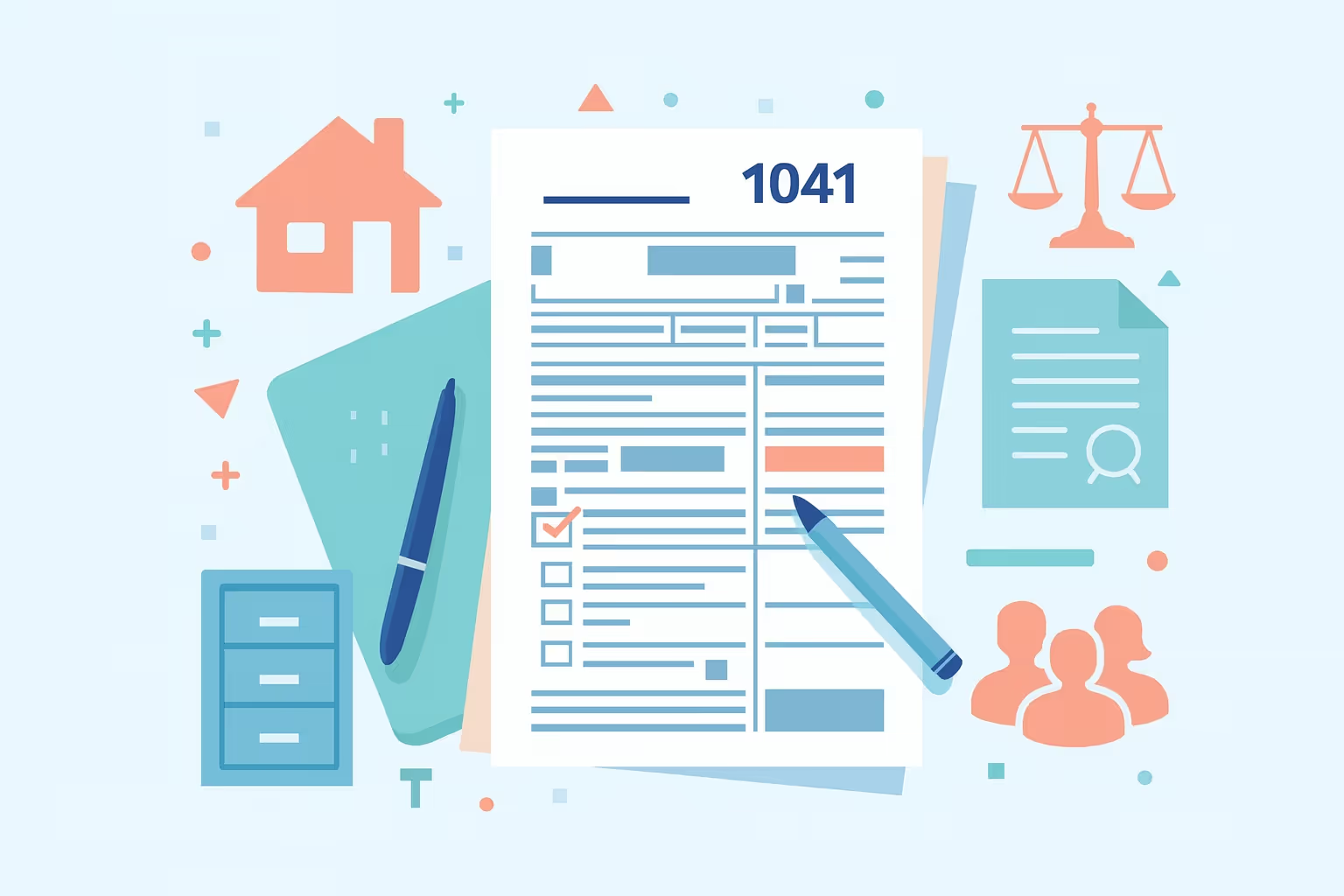Form 1041 2012 Instructions: Estate and Trust Tax Guide
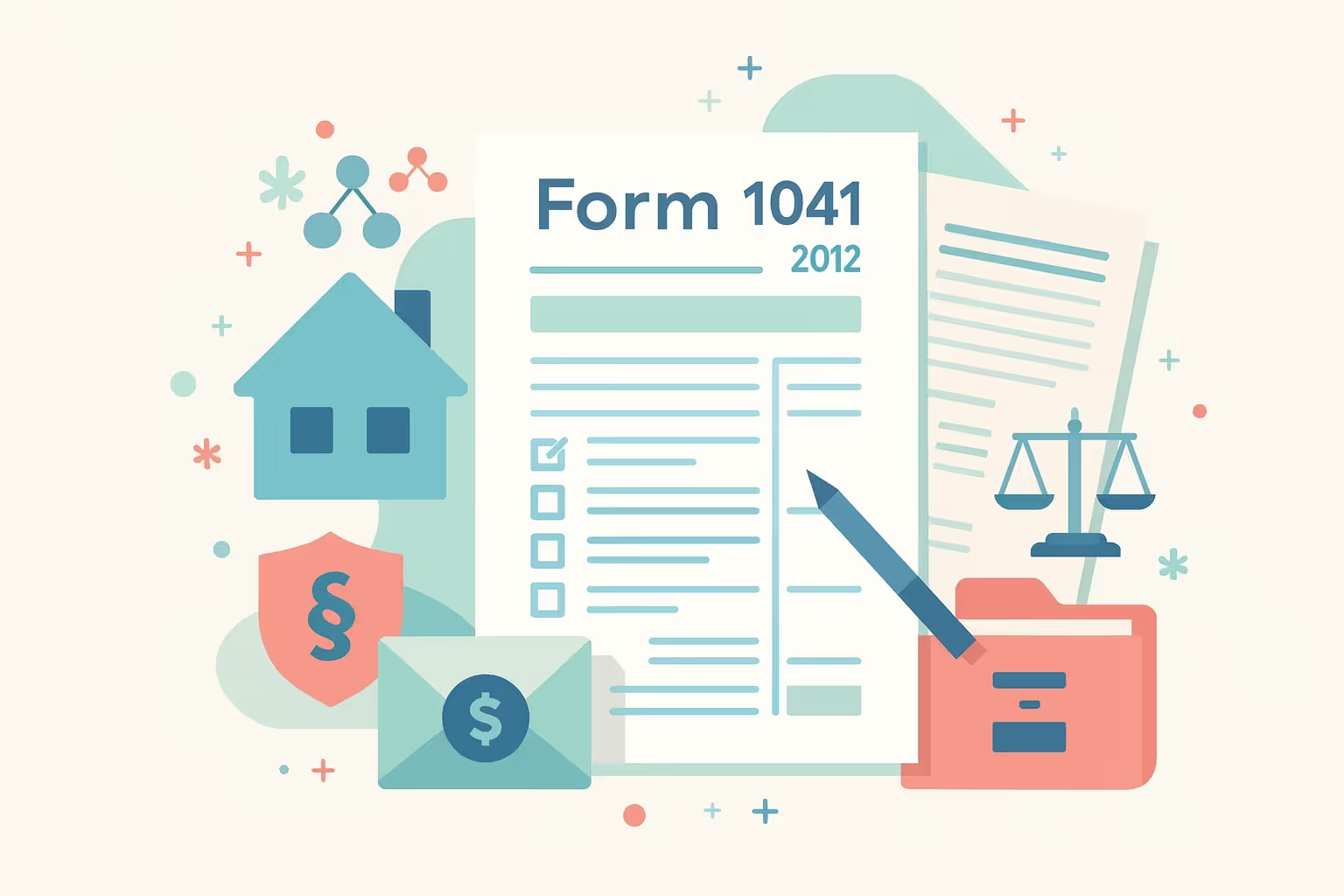
Filing Form 1041 for tax year 2012 requires understanding how the Internal Revenue Service defines and administers an estate or trust for income tax purposes. Form 1041 serves as the fiduciary income tax return, used to report gross income, allowable deductions, and amounts distributed to beneficiaries. Every fiduciary, including executors, trustees, and personal representatives, must comply with the Internal Revenue Code and determine whether the entity pays income tax directly or transfers income taxation responsibility to beneficiaries.
For 2012, federal tax law treats estates and trusts as separate legal entities, each responsible for filing a personal income tax return when annual gross income meets the filing threshold. Fiduciaries must identify income generated from sources such as interest, dividends, or rental activity and determine distributable net income to establish the proper income tax liability. Correctly reporting this information ensures that both the entity and its beneficiaries remain compliant with federal filing requirements.
According to the IRS Form 1041 Overview, the return must include all taxable income, deductions, and distributions made during the year. This official resource provides detailed guidance on who must file, what documentation to prepare, and how to complete the fiduciary income tax return accurately under 2012 rules.
Understanding Estate and Trust Types
Identifying the correct entity type is essential before preparing Form 1041 for the 2012 tax year. Each estate or trust operates as a separate legal entity for income tax purposes, and its classification determines the applicable tax rules. Fiduciaries must evaluate the trust’s governing instrument, its income distribution requirements, and its powers under the Internal Revenue Code to confirm the correct filing approach. Proper classification ensures accurate reporting of gross income, deductions, and distributions.
Domestic Estates
- Created under U.S. law, these estates are required to file a fiduciary income tax return when the income generated during administration exceeds the filing threshold.
- Income earned from investments or rental properties is subject to federal income taxation.
- The estate pays income tax on retained earnings and may distribute income to beneficiaries, who then report those amounts on their personal income tax returns.
Foreign Estates
- Established under foreign law, these entities file U.S. returns only when income arises from sources within the United States.
- The Internal Revenue Service requires disclosure of U.S.-source income for income tax purposes.
- Filing requirements depend on whether the estate has U.S. beneficiaries or domestic income.
Simple Trusts
- A simple trust must distribute all income annually to beneficiaries, who then pay income tax on the distributed amounts.
- A simple trust cannot make charitable contributions or distribute principal during the tax year.
- The fiduciary reports the trust’s distributable net income on Schedule K-1 for each recipient.
Complex Trusts
- A complex trust may accumulate income, distribute principal, or make charitable gifts.
- A complex trust may claim an income distribution deduction for income paid or credited to beneficiaries.
- A complex trust often manages investment portfolios with sufficient income to trigger additional tax obligations.
Grantor Trusts
- The grantor pays income tax directly on income generated by the trust.
- Grantor trusts encompass intentionally defective grantor trusts, which are created for estate planning and asset transfer strategies.
- Income earned within the trust appears on the grantor’s individual tax return.
Qualified Settlement Funds
- A qualified settlement fund is established to hold settlement proceeds and is recognized as a separate taxable entity.
- The fund pays income tax on earnings from qualified investments until those amounts are distributed.
- A qualified settlement fund is frequently used in structured litigation settlements involving multiple claimants.
Revocable Living Trusts
- The grantor retains control and reports all trust income on a personal income tax return.
- Upon the grantor’s death, the trust converts into an estate, requiring its own fiduciary income tax return.
- This structure simplifies asset management while maintaining flexibility during the grantor’s lifetime.
Each entity type follows specific filing requirements under federal tax law. Understanding these distinctions enables fiduciaries to manage assets effectively, maintain compliance with the Internal Revenue Code, and ensure accurate reporting for income tax purposes. A clear understanding of classification also strengthens a fiduciary’s ability to meet annual filing duties and avoid errors during tax preparation.
How Estate and Trust Income Is Taxed
Understanding how income taxation applies within an estate or trust is essential for accurately preparing the fiduciary income tax return. Estates and trusts act as separate legal entities for income tax purposes, reporting income generated from various sources and determining who bears the tax responsibility. Fiduciaries must identify taxable income, calculate the income distribution deduction, and ensure that all income earned is properly attributed either to the entity or its beneficiaries.
Taxable Income and Sources
Taxable income includes all income earned during the tax year unless specifically exempt under the Internal Revenue Code. Common categories include interest, dividends, capital gains, business profits, and rental income. Ordinary income, such as interest or short-term gains, is taxed at the entity’s rates, while qualified dividends and long-term capital gains may receive preferential treatment. Estates and trusts must report gross income, subtract allowable deductions, and determine taxable income before computing the final income tax liability. This calculation ensures that each taxable entity pays income tax only on the portion of its income that is not distributed to beneficiaries.
Distributable Net Income and Beneficiary Reporting
Distributable net income (DNI) determines how much income the fiduciary may distribute without double taxation. The trust’s distributable net income sets the limit on the income distribution deduction, which prevents both the fiduciary and beneficiaries from paying tax on the same income. Beneficiaries receiving distributions report those amounts on their personal income tax returns and pay income tax at their applicable rates. Any income retained within the estate or trust remains subject to fiduciary income tax. Accurate tracking of distributed and retained income ensures compliance and proper allocation of tax responsibilities.
Income Tax Rates and Additional Taxes
For the 2012 tax year, fiduciaries apply graduated tax brackets to determine income tax liability. Higher levels of retained income may trigger surtaxes, such as the net investment income tax. Estates and trusts may also be subject to the alternative minimum tax when certain deductions or preferences apply. These additional obligations require precise calculation and supporting documentation. Maintaining clear records of taxable income, deductions, and credits promotes compliance and supports accurate filing.
The IRS 2012 Form 1041 Instructions provide detailed guidance for computing fiduciary income tax, including procedures for reporting gross income, identifying deductible expenses, and applying tax credits. This resource helps fiduciaries ensure that every item of income and deduction is correctly reflected for tax purposes. Understanding these requirements allows fiduciaries to manage income taxation effectively and maintain accountability to both the Internal Revenue Service and the beneficiaries they serve.
Filing Requirements for Form 1041 (Tax Year 2012)
Fiduciaries managing an estate or trust must understand the federal filing requirements governing Form 1041 for tax years beginning in 2012. Each entity is treated as a separate legal taxpayer for income tax purposes and is responsible for reporting all income generated, calculating taxable income, and determining the income tax liability owed. Proper filing ensures compliance with Internal Revenue Service regulations, accurate reporting of fiduciary income tax, and timely submission of required documentation.
1. Determine Whether Filing Is Required
- Filing Thresholds: An estate or trust must file Form 1041 when the annual gross income equals or exceeds $600.
- Taxable Income: Trusts must file if they have any taxable income or if beneficiaries receive distributions during the year.
- Nonresident Beneficiaries: Filing is mandatory when a nonresident alien is a beneficiary, regardless of income level.
- Foreign and Domestic Estates: Both foreign and domestic estates are required to file if income is earned from U.S. sources.
2. Prepare Essential Identifiers
- Employer Identification Number (EIN): Each estate or trust must obtain an EIN before filing a fiduciary income tax return.
- Taxpayer Identification Accuracy: The fiduciary must ensure all names, addresses, and taxpayer identification numbers match IRS records.
- Consistent Entity Information: Uniform reporting across schedules, including Schedules K-1, strengthens compliance.
- Supporting Documentation: Maintain income statements, expense receipts, and records showing distributions or transfers of trust assets.
3. Confirm Filing Deadlines
- Calendar-Year Filers: The filing deadline for 2012 returns was April 15, 2013.
- Fiscal-Year Filers: Entities operating on a fiscal year must file by the 15th day of the fourth month following the end of the fiscal year.
- Extensions: A fiduciary may file Form 7004 to obtain an automatic extension, though tax payments remain due on the original deadline.
- Record Retention: Retain all filed returns, supporting schedules, and financial documentation for at least three years.
4. Verify Compliance Before Submission
- Accuracy Review: Confirm that income earned, deductions claimed, and credits applied reflect verifiable financial data.
- Beneficiary Schedules: Ensure each beneficiary receives an accurate Schedule K-1 reflecting their share of distributable net income.
- Payment Obligations: Submit tax payments timely to avoid additional income tax liability.
- Audit Preparedness: Maintaining organized records and verifying entries helps resolve any inquiries from the Internal Revenue Service.
Fiduciaries who meet these requirements strengthen the accuracy and reliability of the estate or trust’s tax return. Adhering to annual filing rules, maintaining transparent documentation, and meeting deadlines establishes a clear record of compliance for future tax years, supporting the responsible management of fiduciary duties. A structured approach to filing also ensures the fiduciary fulfills all federal obligations while protecting both the estate’s assets and the interests of its beneficiaries.
Step-by-Step Guide to Completing Form 1041
Preparing Form 1041 for tax year 2012 requires accuracy, organization, and a clear understanding of fiduciary responsibilities. Each process step must accurately reflect the entity’s financial activity and comply with the Internal Revenue Code’s requirements for income taxation.
Fiduciaries should gather all relevant tax forms, verify entity details, and confirm the correct allocation of income and deductions to ensure accuracy and completeness of the records. A structured preparation process ensures that the estate or trust meets federal obligations and avoids unnecessary delays.
Step 1: Gather All Required Records
Begin with a comprehensive document review. Collect income statements, bank records, and investment reports to capture all income generated during the tax year. Assemble receipts for deductible expenses, proof of charitable contributions, and supporting schedules for capital gains. Include prior-year returns and legal documents such as the will, trust agreement, or amendments that define distribution requirements.
Step 2: Verify Entity Identification
Confirm that the estate or trust has a valid Employer Identification Number. Use consistent entity names and addresses on all tax forms and attachments. Identify the fiduciary responsible for filing, whether an executor, trustee, or personal representative. Check that all taxpayer identification numbers, including those of beneficiaries, match Internal Revenue Service records.
Step 3: Report Income Earned During the Year
List all sources of income, including interest, dividends, business profits, rental income, and capital gains. Separate ordinary income from qualified dividends and long-term capital gains, as each may be taxed differently. Include all income-producing assets held within the trust or estate, and attach supporting schedules such as Schedule D for capital transactions.
Step 4: Deduct Allowable Expenses
Identify all deductible expenses directly related to administering the estate or trust. Include fiduciary fees, accounting and tax preparation costs, attorney fees, and state or local taxes. Record charitable contributions made from gross income when authorized by the governing instrument. Review all deductions carefully to ensure they comply with income tax purposes under federal law.
Step 5: Calculate Taxable Income and Liability
Subtract total deductions from gross income to determine taxable income. Apply the 2012 tax brackets for estates and trusts to calculate the fiduciary’s income tax liability. Consider applicable tax credits or prepayments made during the year. If the entity meets conditions for the income distribution deduction, record the corresponding amounts distributed to beneficiaries.
Step 6: Complete Required Schedules
Attach all necessary schedules, including Schedule K-1 for each beneficiary, which reports their share of distributable net income. Include Schedule G for tax computation and Schedule B for the income distribution deduction. Ensure each schedule aligns with figures reported on the primary return to maintain consistency and accuracy.
Step 7: Review, Sign, and File the Return
Conduct a final review of all figures to ensure totals reconcile across every page. The fiduciary or authorized paid preparer must sign and date the return. Verify that supporting forms are attached in the correct order and that all required pages are completed. Submit the return electronically through approved filing software or by mail to the proper IRS service center.
Completing Form 1041 methodically helps fiduciaries demonstrate diligence and compliance with federal tax law. A well-organized return supports transparency, simplifies future reporting, and promotes accurate allocation of tax responsibility between the estate or trust and its beneficiaries. This structured approach reinforces the fiduciary’s role in managing assets responsibly and meeting all filing obligations for the 2012 tax year.
Filing Methods and Payment Options
Fiduciaries completing Form 1041 for tax year 2012 can submit the fiduciary income tax return electronically or through traditional mail. Each filing method carries specific requirements to ensure proper processing and timely acknowledgment by the Internal Revenue Service.
Choosing the most efficient method depends on the estate or trust’s filing history, access to authorized software, and preference for recordkeeping. Whether filing electronically or on paper, accurate submission of all required schedules and payment documentation is critical to maintaining compliance.
Electronic filing remains the preferred option for many fiduciaries because it offers speed, security, and confirmation of receipt. Entities filing electronically must use approved IRS software and include all required attachments, such as Schedules K-1 and supporting statements.
E-filers can authorize payment directly from the estate or trust’s bank account or use the Electronic Federal Tax Payment System to submit funds separately. Paper filing remains an acceptable option when electronic submission is unavailable, although it requires additional preparation and careful assembly.
Accepted Filing and Payment Methods
- E-file (PIN or signature method): Fiduciaries sign electronically using a self-selected Personal Identification Number or complete Form 8453-F to mail a signed declaration within three business days.
- Paper Filing: Assemble the return in order, starting with Form 1041, followed by schedules and attachments. Include a signed original and maintain a copy for the fiduciary’s records.
- Electronic Federal Tax Payment System (EFTPS): A secure platform for scheduling federal tax payments directly from the estate or trust’s bank account. Enrollment is required before use.
- Direct Debit: Available when filing electronically, allowing automatic withdrawal of the balance due on the selected date.
- Check or Money Order: Payable to “United States Treasury,” with Form 1041-V attached for accurate processing. Include the entity’s Employer Identification Number and “2012 Form 1041” on the payment.
- Estimated Payments: Fiduciaries who anticipate future income tax liability may submit quarterly estimated payments using Form 1041-ES.
Before filing, fiduciaries should review all forms for accuracy and verify that total payments correspond with reported liabilities. Timely filing and payment prevent additional costs and strengthen the accuracy of the fiduciary income tax record.
Choosing the correct filing method helps ensure proper application of payments, maintains compliance with the Internal Revenue Code, and supports efficient administration of the estate or trust’s financial obligations. Organized documentation and reliable payment methods reinforce the fiduciary’s duty to manage tax responsibilities responsibly.
Common Filing Errors and Recordkeeping Tips
Fiduciaries managing an estate or trust must ensure the accuracy of every detail reported on Form 1041. Even minor oversights can impact income tax liability, lead to processing delays, or prompt inquiries from the Internal Revenue Service.
Careful review and strong recordkeeping practices strengthen compliance, support audit readiness, and maintain transparency for beneficiaries. Avoiding common mistakes helps establish a reliable fiduciary income tax record and protects both the entity and the fiduciary from unnecessary complications.
- Entity Misclassification: Reporting a simple trust as a complex trust or vice versa alters exemption amounts and taxable income calculations. Review the trust instrument to confirm distribution requirements and allowable deductions before filing the fiduciary income tax return. Misclassification can cause errors in income allocation and distort the entity’s income tax liability.
- Incorrect Exemption Amounts: Estates and trusts must apply the correct exemption based on classification. Estates claim a $600 exemption, simple trusts claim $300, and complex trusts claim $100 for the 2012 tax year. Using incorrect figures can impact taxable income and result in a misreported tax liability.
- Missing or Inaccurate Schedules K-1: Each beneficiary receiving distributable net income must receive a Schedule K-1 reflecting their share of taxable income. Failure to issue or include these schedules leads to inconsistencies between the fiduciary’s filing and the beneficiaries’ personal income tax returns. Verify that totals reconcile with amounts reported on the primary return.
- Incomplete Documentation: Retain supporting evidence for income earned, deductions claimed, and distributions made. Maintain receipts, bank statements, and prior-year returns to substantiate reported figures. Incomplete records weaken audit defense and complicate future tax preparation.
- Late Filing or Payment: Missing deadlines or delaying tax payments results in interest charges and additional costs. Establish a filing calendar and submit payments through reliable methods such as the Electronic Federal Tax Payment System or direct debit to avoid late fees.
- Failure to Seek Professional Guidance: Fiduciaries should obtain qualified legal or tax advice when managing complex tax returns or handling specialized types of income. A professional review ensures the accurate interpretation of the Internal Revenue Code and strengthens compliance with federal income tax requirements.
IRS Publication 559 – Survivors, Executors, and Administrators, outlines fiduciary responsibilities, including guidance on managing estate taxes, filing requirements, and recordkeeping standards. Consulting this publication helps fiduciaries verify exemption limits, filing procedures, and reporting obligations for estates and trusts. Meticulous documentation, timely filing, and professional oversight foster accuracy and accountability, enabling fiduciaries to uphold their responsibilities with confidence and clarity.
Special Trust Situations and Additional Considerations
Some trusts require specialized handling because their tax treatment differs from traditional estates and standard fiduciary arrangements. Understanding these distinctions ensures compliance with the Internal Revenue Code and helps fiduciaries apply the correct income taxation rules. Entities such as grantor trusts, foreign trusts, and those involving qualified investments must follow separate filing requirements to report income accurately and manage their income tax liability effectively.
A grantor trust allows the creator, or grantor, to retain certain ownership powers or rights over the trust’s assets. Because of this retained control, the grantor pays income tax on the trust’s income through a personal income tax return rather than filing a separate fiduciary income tax return.
Some grantor trusts, including intentionally defective grantor trusts, serve as estate planning tools, enabling wealth transfers while allowing income generated from trust assets to flow through to the grantor’s individual return. Foreign trusts, on the other hand, are administered outside the United States or controlled by non-U.S. persons and may be required to file Form 3520 or Form 1040-NR if they earn U.S.-source income or hold qualified investments domestically.
Certain specialized trusts may also be subject to additional requirements, such as the alternative minimum tax (AMT) or reporting related to qualified opportunity funds. The AMT applies when deductions and credits reduce taxable income below the standard limits, requiring separate calculations to determine the additional tax owed.
Trusts investing in qualified opportunity funds must confirm their eligibility for deferred gain treatment and comply with the applicable reporting standards. Strategic management of trust assets, accurate tracking of income generated, and consultation with professionals when needed support precise reporting and adherence to fiduciary income tax rules.
Frequently Asked Questions
What entities must file Form 1041 for the 2012 tax year?
Fiduciaries responsible for managing a decedent’s estate, domestic trust, or bankruptcy estate must file Form 1041 if the entity earned $600 or more in gross income during the year. A filing is also required if any beneficiary is a nonresident alien or if the trust has taxable income. Each entity must maintain records that accurately reflect income taxation and deductions to ensure compliance with federal reporting requirements.
How does the income distribution deduction work for beneficiaries?
The income distribution deduction allows estates and trusts to reduce taxable income when they distribute earnings to beneficiaries. The deduction equals the lesser of the trust’s distributable net income or the total income distributed. Beneficiaries then report these amounts on their personal income tax return and pay any associated tax. This process ensures that income taxation is applied only once, either at the entity level or the individual taxpayer level.
When is an Employer Identification Number required for filing?
An Employer Identification Number is required before submitting a fiduciary income tax return. The number identifies the estate or trust as a separate taxable entity for federal tax reporting purposes. A fiduciary exercising primary supervision over the entity’s financial activities must use this identifier on all forms, schedules, and correspondence. Using the correct Employer Identification Number ensures that all reported income, deductions, and payments align with IRS records for proper tax purposes.
Are estates subject to both income taxation and estate taxes?
Yes, a decedent’s estate may owe both income taxes and gift and estate taxes, depending on income generated during administration and the total value of transferred assets. Income earned after death, such as rental income or investment gains, is reported on Form 1041. The overall estate value, including property and financial holdings, determines whether an estate tax return is required in addition to the income tax return.
What is the role of the fiduciary in tax preparation?
The fiduciary is responsible for tax preparation, accurate recordkeeping, and timely filing of the trust’s income tax return or estate tax return. This role includes reviewing all income earned, allowable deductions, and distributions to beneficiaries. A fiduciary must exercise primary supervision over all financial transactions and maintain compliance with tax laws. Proper oversight and documentation support accurate filing and accountability throughout the tax year.
How does the alternative minimum tax affect estates and trusts?
The alternative minimum tax (AMT) applies when deductions or credits reduce taxable income below federal thresholds. Estates and trusts must calculate AMT separately to determine if additional tax is owed. The fiduciary must review all income sources, deductions, and investment strategies when assessing potential AMT liability. Applying the correct calculation ensures that the entity fulfills its income taxation obligations while maintaining compliance with federal standards.
Do pre-need funeral trusts need to file Form 1041?
Yes, pre-need funeral trusts must file Form 1041 annually if they generate income from investments such as interest or dividends. These trusts are established to hold funds designated for future funeral expenses and may qualify for simplified reporting under specific IRS provisions. The fiduciary must ensure that all income, deductions, and credits are accurately reported and that the filing aligns with applicable rules governing fiduciary income tax returns.






